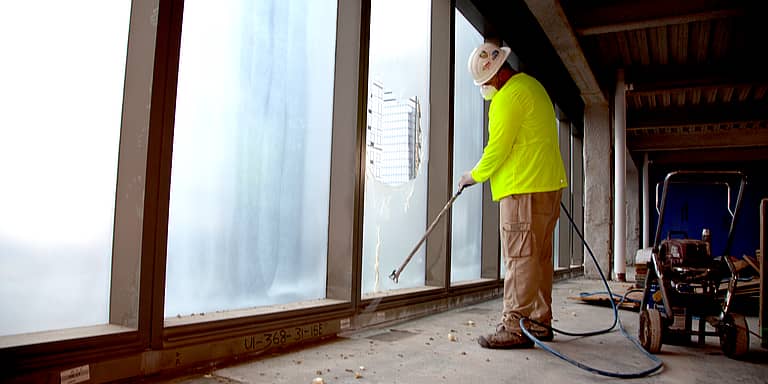A recent hotel project on Ocean Boulevard in Myrtle Beach, S.C., fell months behind schedule. The piling subcontractor showed up late and understaffed. A crew of 25 to drive pilings in place would have sufficed, but only 10 piling guys labored on site. They finished in February—late. It pushed the delivery dates for all subsequent construction into the spring and summer.
Summer is money for Myrtle Beach hoteliers. They want their new hotels and timeshares ready for the entire vacation season, not just for part of it. So, unless a wormhole opened over Coastal South Carolina and allowed 12 weeks of wall construction to slip into seven weeks of earth-time, the project’s drywall contractor would have no choice but to accelerate his schedule.
“I’m last in line,” says Danny Bonnell II, president of Commercial Systems Plus, Inc. in Myrtle Beach, South Carolina. “Think they’ll say, ‘Danny, you get another month to finish your work, because of the [bleeping] piling guy’? Yeah, like that’s going to happen.”
Talent Management
Working fast when staffing is low puts stress on construction delivery. Labor is hard to find, nowadays, especially skilled labor. Worker stress is a huge problem.
Last year, the “Global Human Capital Trends” report from Deloitte University Press identified the “overwhelmed employee” as an emerging trend. The latest 2015 report noted that the issue has spread—24 percent of respondents, versus 21 percent last year, say that aiding overwhelmed employees is “very important.”
While the Deloitte survey was conducted globally, it hints at the state of all employees’ work environments, including those of drywall hangers, finishers, foremen and superintendents. Stress is high. There’s a sense of the need to overhaul work—to streamline it and reinvigorate management—to help crews focus, work faster and maintain quality standards.
“We are entering an era of ‘doing less better’ rather than ‘doing more with less,’” states the Deloitte report.
Actually, drywall contractors want to and need to “do more sooner.” But, this involves training.
“It’s not a body problem, it’s a skill problem,” says Bonnell, whose payroll dropped from 200 to 30, though it’s back on the rise. “It’s been tough getting skilled labor back on board.”
“If you can’t ramp up as fast as the market, you’re going to miss out on work,” adds Jeffrey Burley, president, B&B Interior Systems, Inc., Plantation, Fla. “There’s work I could be getting that I’m letting go by. I can’t find estimators and project managers fast enough.”
Before the Great Recession, most drywall contractors could run projects by the book. Reasonable delivery expectations were written into contracts. Most construction documents were complete, and crews could focus on production. The economics of bidding meant that most jobs came with plenty of gross margin to accommodate overruns.
No longer.
Today, drywall companies operate on thin margins and have tight timeframes and green workforces. They have to bend time, so to speak, to make things work. And while new crew members are eager to learn, their training takes time. It calls for a serious management commitment at the top.
“We’ve had to address our career-minded young men,” says John Hinson, division president at Marek in Coppell, Texas, an open shop. “We have ‘construction laboratories’ in our warehouse, and I speak to these new hires at least once a week.”
At these meetings, Hinson spends 20 minutes with the recruits. But the company’s director of talent management also makes visits to all company operations, spending time regularly with office personnel, field superintendents and top executives.
“I need direction, too,” Hinson says. “I’m just as susceptible to falling into the same routine over and over again unless someone says, ‘You need to do this and this to help your team.’”
The question becomes how to implement all of this training.
For his part, Bonnell tries to accelerate the learning curve for his new hires. He realizes, however, that it takes a sizable allocation of management resources in order to enact workforce development.
“An eight-hour day has turned into a 12-hour day,” says Bonnell about the workload needed to meet construction schedules.
That’s four extra hours a day that Bonnell also needs his managers to work. So, he’s deployed more managers to effect site supervision and provide instruction. They spend more time there than they used to, he says. He calls it “being in babysitting mode,” but he’s being facetious with his word choice. It is, in fact, a skills development program, and new hires are responding well to the training.
“I started 14 months ago, and now I’m in pretty good shape,” Bonnell says. “I’ve got new guys who have gone from laborers to skilled mechanics. They’re out on their own as the new guys come in.”
New Thinking
For eons, managers have tried to figure out the art of managing people. More than a decade ago, the popular 2002 Harvard Business Review article, “Beware the Busy Manager,” noted that managers value time more than any other resource, but few use it well.
“Our findings on managerial behavior should frighten you,” the HBR researchers wrote. “Fully 90 percent of managers squander their time in all sorts of ineffective activities.”
The time wasters identified included a mix of procrastination, succumbing to distractions and undertaking tasks without being fully engaged. Managers can be trained, and for some managers the ability to supervise comes naturally. But, all told, management development can’t be rushed. Refining, developing and molding managers takes time. Sharpening a manager’s proficiency is complicated.
“Trying to prevent managers from losing energy or focus (or both) is an ambitious proposition,” HBR said. “It involves paying far more attention to how individual managers perceive the broad meaning of their work, what challenges they face, and the degree of autonomy they enjoy.”
In other words, don’t expect your HR department to solve problems quickly. A shallow company memo sent to managers with little tips and suggestions won’t help them to develop sensibilities, reasoning capability and good decision-making capacity.
“It can’t be done by pulling small-scale HR levers,” HBR said. “It can only happen with vision, oversight and commitment from the top.”
Still, many drywall companies that put off workforce development during the recession have now begun to act. They’re working to upgrade the cultural context in which their managers and crews get trained. It often starts with one function: hiring.
“We’re having our eyes opened with recruiting,” says Craig Daley, president, Daley’s Drywall & Taping, Campbell, Calif. Daley’s payroll is currently 208 employees, though he says 250 to 350 is typical for the firm.
Daley has made an investment in recruitment processes. He’s hired a consulting firm to define job requirements, script questions to use in candidate interviews, design a system for scoring candidates’ answers and implement a scheme for assessing personality traits and professional capabilities.
“We’ve always done this by the seat of our pants,” Daley says. “Now, we’re going through a series of evaluations that score and rate [a person’s] mental acuity, capability with numbers and overall competitiveness. We’ve never been so formal.”
Daley says his new recruitment program will help his firm to select better employees. But best of all, he says, it will capture an understanding of employees’ capabilities earlier in their careers. This will help train and groom them and, in the long run, keep them.
“The first thing you do is [define] the qualities you want in an estimator—the five or 10 things a good estimator should have,” says Daley, whose firm was looking to hire an estimator/project manager at press time. “That goes into a set of interview questions and then a second set of questions. It’s all very detailed.”
Similar workforce development efforts are happening at other drywall firms.
“I’m trying to bring in younger people,” says Burley, who had 200 to 300 employees in the field in 2007 and now has 80 on payroll. “It’s good to have the older guys and their experience, but you can’t be too old to ignore new thoughts. You’ve got to bring in new ways of thinking—the millennials.”
Burley wants to tap into this new generation, train them, benefit from their ideas and, ultimately, retain them as future managers and leaders of the company.
“People want to advance their careers. They want to become part of the culture of your company,” Burley says. “I look on an annual basis to see where people are, and we talk. A big part of my workforce is hungry.”
Open Forum
Yes, most employees crave jobs that have meaning. A 2013 Gallup survey, however, found that only 30 percent of employees feel engaged by their employers and their jobs. Follow-up sampling by Gallup each year since 2013 shows the same trend line: Only three in 10 workers are happy—specifically, 29 percent are in construction.
At the other end of the spectrum, 20 percent of employees are actively disengaged at work. These folks are a problem because they can spread discontent among peers and in the labor market.
That leaves 50 percent of workers who just sort of float along—agenda-less, unmotivated, not fully committed to their work.
Gallup also found that the top 25 percent of all worker teams have, in comparison to the bottom 25 percent, nearly 50 percent fewer accidents and 41 percent fewer quality defects. They also incur far less in healthcare costs.
“Having too few engaged employees means our workplaces are less safe,” Gallup states. “[Such] employees have more quality defects, and disengagement—which results from terrible managers—is driving up the country’s healthcare costs.”
Burley isn’t bothered by such statistics. Good incentives, he says, keep construction workers on the job.
“You’ve got to pay people well, and you’ve got to incentivize them,” Burley says. “That’s why 70 percent of them might be looking for work [according to Gallup’s statistics].”
By paying a little more per hour than competitors and offering a competitive health-care plan, Burley feels a drywall firm can woo a young job candidate and retain him. In other words, Gallup’s 30/70 engagement/disengagement stat is just the opposite in the drywall trade.
“I say I have 70 percent who are engaged and like working here,” Burley says. “The other 30 percent of the workforce will always require some attention.”
Thinking somewhat differently, Daley hopes to engender openness at work so as to drive higher levels of trust among his workers—and keep them. He’s been opening up more of the company’s books to his managers. This, he says, improves employee engagement.
“We’re giving them [foremen and superintendents] our budgets—fully disclosed, fully itemized—on every activity they handle,” Daley says. “We’re quite open with our estimates and hours. We used to be guarded with that information.”
The objective?
“Transparency brings trust, and trust brings content employees,” Daley says. “If you’re less secretive and more open—and avoid having competing job-cost and project-management systems—then for somebody responsible for running projects no one is pulling their chain and trying to get them motivated. They see the numbers.”
But transparency is a two-way street. To remain competitive, Daley is monitoring and measuring workflow more closely and more frequently than he did prior to the recession. He has installed digital production control (DPC) software to track productivity.
“We’ve pushed it since the recession,” Daley says. “Some foremen felt it was time-intensive and were reluctant to divulge the information. But over time they’ve accepted it and, actually, have come to demand that we get DPC set up every time we hand them a job.”
The software identifies workflow metrics and helps to highlight decision opportunities when building walls and ceilings.
“The math can be done by hand, but so many things are happening—a 9-foot wall at 80 feet a day, backing at 30 feet a day, an 8-foot light soffit at 60 feet a day,” Daley says. “In the old days, we didn’t bother with the math. We’d look at hours-compared-to-bid maybe once a month.”
While it’s become a challenge to manage the productivity of work crews ever since the economy began growing, the process is clearly becoming a priority in drywall construction.
Keeping Pace
These days, most drywall companies need workers. If you’re fortunate to have seasoned managers on staff, you need them to groom the new hires coming on-board. This takes time.
“I’ve had to use a lot of my management guys,” Bonnell says. “I’ve put them on jobs to keep things on pace. They used to make one or two visits a week to the jobs, but now it’s an everyday thing.”
Complicating matters is the new order of the day. General contractors in Bonnell’s market and elsewhere have been shortening the work schedules for projects. They want the work done faster—and cheaper. It’s not so easy to deliver the goods when the potential for getting short-changed on time is so great.
“You have the inexperience of some of our guys and the inexperience of what’s at stake with today’s time crunch,” Bonnell says. “You have the perfect storm.”
Mark L. Johnson is an industry consultant who writes about management, leadership and employee engagement. He can be reached at @markjohnsoncomm and linkedin.com/in/markjohnsoncommunications.








